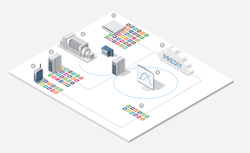Over the last decade, propelled by the rise of smartphones and the app economy, there has been an arms race in the consumer world to build immense computing capabilities, and as a result we have seen tremendous improvements to our quality of life and productivity as individuals. From travel to fitness to entertainment, connectivity and apps keep our lives running smoothly in ways we never knew we needed and now cannot imagine life without.
Now the industrial world is joining the game, as advancements in data storage, cloud computing, and wireless technology have ushered the industrial sector to a tipping point. Global industry is on the cusp of total transformation, similar to the consumer world at this time a decade ago when smartphones were becoming mainstream and widespread.
Connected Controls Open the Door to Industrial Internet
I often describe controls as the “brain” of an asset. Therefore, internet-connected control systems are an understandably foundational infrastructure of this industrial internet.
Unfortunately, the technological advancements of the industrial internet are outpacing the upgrade cycles for many machines’ control systems and the control systems of yesterday are not up to the task. The average traditional control system can only use about 3% of data from industrial assets and cannot adapt to changing conditions in real time. They also cannot automatically upgrade internal software and security patches, making the machines vulnerable to security issues and productivity loss. In short, machines with these old control systems are like people without an iPhone. There are nearly limitless possibilities to function more smoothly and efficiently, but this potential is inaccessible without connectivity.
Connected controllers are a turning point in the realization of the industrial internet, bringing together the physical and digital worlds at the farthest edge of manufacturing and sparking the rise of an economy for industrial apps. Like connected people, they can take and enable more intelligent action. In this new paradigm, control systems are no longer passive devices, disconnected from outside data and business outcomes. Instead, connected control systems are already changing how machines operate and communicate, accelerating the pace at which the digital world influences physical systems. These new controllers are bringing apps to the machine’s level for the first time, enabling machine learning at scale, and creating economic efficiency.
To give one example, Carestation Insights, a secure health cloud platform built on GE’s operating system Predix, uses connected controls to collect data from anesthesia machines, analyzes trends, and uncovers insights that improve patient care and boost the efficiency of the operating room. The Department of Anesthesia at the Canterbury District Health Board in New Zealand has successfully reduced fresh gas flow rates by 13%, unlocking clinical, ecological, and financial benefits.
Connected Controls Integrate Edge Computing and Cloud Computing
All connected controls systems are not created equally, as it is, the software that runs on them is what makes them powerful. An edge-plus-cloud architecture is key to fully realizing the benefits of the industrial internet, as real-time response is needed at the machine-level. Edge computing enables data analytics to occur and resulting insights to be gleaned closer to the machines. From Google maps to weather apps, consumers have been experiencing the benefits of marrying cloud and edge computing for years. While edge computing is not new, it is beginning to take hold in the industrial sector.
The edge is much more than a way to collect data for transmission to the cloud. It allows machines to collect, process, analyze, and—most importantly—act upon data within milliseconds because it happens right there at the machine. Edge computing will make Big Data actionable for the first time.
The harsh and remote conditions of many industrial sites make it challenging to connect and cost-effectively transmit large quantities of data in real-time. Through connected controls, edge computing embeds intelligence on the machines themselves, bringing analytics closer to the machine, and providing a less expensive option for optimizing asset performance. Take windfarms, for example. When the wind changes direction, edge software can collect and analyze this information and prompt the entire field of wind turbines to adjust the pitch of their blades and capture more kinetic energy.
At the other end, cloud connectivity supplies machines with external information that would otherwise be unavailable. For example, when connected to the outside world, electrical machinery can reduce energy costs by operating when the price of power is lowest.
Apps Change the Game
GE’s Industrial Internet Control System (IICS) is already changing how machines operate and communicate, by bringing apps to the machine level for the first time, enabling machine learning at scale, and creating economic efficiency. They have brought productivity gains of 22% and a maintenance cost reduction of 40%.(Courtesy of GE)
This new era of controls that are smart enough to process data at the machine-level and that are connected to outside sources of information has set the stage for the industrial app economy. These internet-enabled controllers can run multiple apps simultaneously, multiplying benefits many times over. The ecosystem of edge offerings is growing and accelerating widespread adoption across the industrial sector.
As machines and people become more interconnected, machines will begin to use apps the same way as consumers do—to improve health, boost productivity, learn from each other, and more. Already, apps can tell jet engines how to reduce fuel consumption and can monitor machinery such as gas turbines to predict faults and prompt preventive maintenance that eliminates the downtime. To gain and maintain a competitive edge in this new era of software-defined machines, it is no longer enough for a machine’s control system to keep it running the same way day in and day out for its entire lifecycle. Unlocking the value of the industrial internet begins at the machine level with a connected control system. Global industry is entering a new era, and there is no sign of slowing down.

